Chicken coop windows
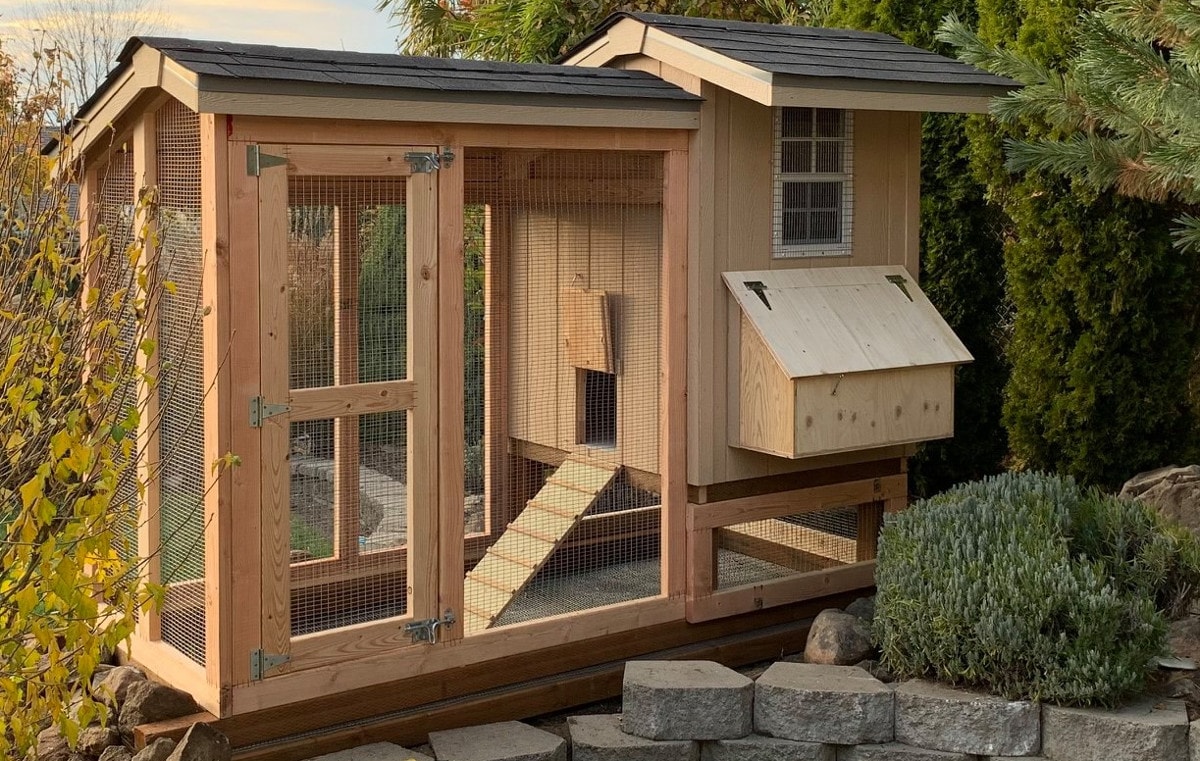
Chicken coop windows are a funny thing that seem to divide keepers, some insisting on more than one for a light and airy coop and others insisting that a single small one is fine.
Chicken coops need at least one window to let light in. Chickens are light sensitive birds and the laying cycle is governed by having enough hours of daylight. My preference is for the window to face the rising sun to get the chickens up at the earliest time possible.
One lesson I learned many years ago is not to add windows with the plan to use them as ventilation, windows are all about light and ventilation should be a separate issue.
Below: The standard chicken coop window layout.
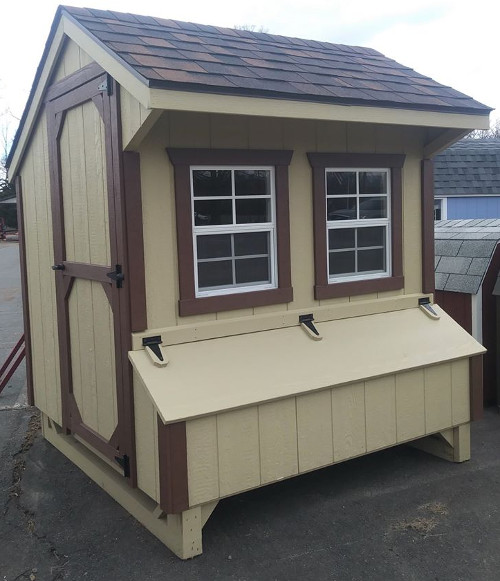
Some coops, mostly small ones, either have little windows or in some cases don’t have any windows at all.
With large walk-in style coops, a large window can be quite nice to allow some extra light and air in whenever the weather is good and can also make it a bit more pleasant and less dusty for you when you're cleaning.
Do chicken coops need windows?
Ideally a coop needs at least one window to let light in. Chickens are light sensitive animals and daylight regulates their both the egg laying and moulting.
Windows really ought to be of such a size and position that the sunlight can reach every part of the floor space during some part of the day. Though we all believe in the benefit of sunlight, we do not always realise how important a part it plays in the care of poultry.
When we consider that vermin and disease thrive in its absence, and that remedial measures are more or less troublesome and expensive, we will work into our building schemes every possible inlet for sunlight.
Below: Would you want to live in a house with no windows?
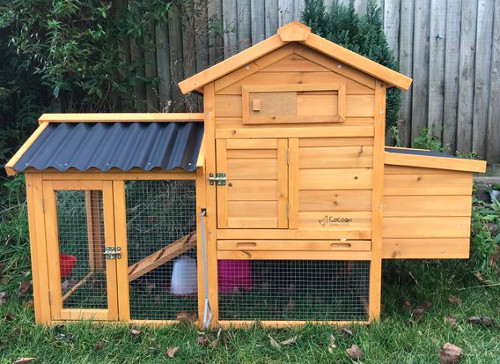
My coops all have at least one large window that faces the early morning sun.
More than one is probably overkill unless you have a very large coop. You can have too many windows in your hen house and the chickens might not want to use the nest boxes if it is too bright inside and you could find yourself hunting for hidden nests.
Also if you have too many windows roosting time may be a long drawn out affair with birds getting on and off the perches rather than settling down to sleep.
Do more windows equal better ventilation?
They can do, but you shouldn't plan on using windows only for light and ventilation. You will still need ventilation in the depths of winter when it's cold and the windows are shut.
If you live somewhere where it freezes or is dark for extended periods of time you will need to add lights as well as the windows will be useless at that time.
Chickens have a delicate respiratory system and so it’s very important that your coop has separate and well controlled ventilation to avoid respiratory diseases in your chickens.
How many windows should be in a chicken coop?
One good sized window is sufficient for most backyard chicken coops unless it is very large.
The reality is the number of windows in a chicken coop varies with size and personal preference. The very small coops, like the flat pack ones you buy from national chains, seem to either no windows or a fancy little flap with 4 bits of 4 inch square plastic in.
The standard 4 x 8 foot or 6 x 12 foot coop for backyard chickens will be just fine with one large window facing the early morning brightness.
If you can read a newspaper in the coop then there is plenty of light for your chickens.
What size should a chicken coop window be?
Chickens quite like dark secluded areas for their nesting areas so small windows are not necessarily a problem. Also having a brightly lit coop at the end of the day when the birds are going to roost could also present some problems.
A chicken coop window should be at least 2 foot long by 1 foot tall (or 2 Square foot) and bring enough light into the coop for you to read a newspaper by. Bigger hen houses will need bigger windows or a second smaller one.
Bear in mind, the more windows you have, the more it will be be to fit them and the more materials you will need and the longer it will take.
As with so much around the building of chicken coops, simplicity is the key to both happy chickens and happy keepers.
Coop windows can definitely be too big or too small, if you are worried that you may not have enough window space, add a second one but put in a shutter to cover it if needed.
What type of window is best for a coop?
Simple is always the best option, it should work in all weathers. All my coops are based on sheds so most of mine have the standard sized plastic panel in a basic frame in the wall.
What material should a coop window be?
This will vary depending on your location and what predators you need to keep out.
Coop windows are a standard wooden frame with either a glass or plastic panel fitted in the hole. The reason most are like is, it is easy to produce, cheap, easy to clean and does it's job well.
With hen houses you really have 4 choices for coop windows:
- Clear, red or opaque plastic sheet. Plastic is easily cut or bought in ready cut sizes, sturdy and easy to install. It is also easy to clean and does not rot. Red plastic sheet is good for poultry as it lets the right colour light into the coop.
- Plexiglas.
- Glass.
- Mesh, weld mesh or hardware cloth.
How do you make a chicken coop window?
Make Your Own Windows - Handy hen keepers can make a working window with a few bits of lumber, a piece of Plexiglas, a couple of hinges and a screen-door hook. Scrap pieces of wood cut down to 2-by-2 or 1-by-4 and screwed together will work.
Below: Second hand windows can often be had for no money at all.
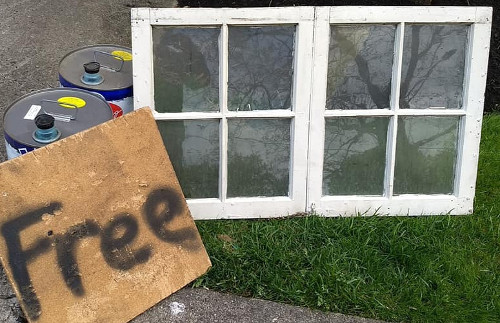
It doesn’t have to be rot-resistant wood because the roof will keep it mostly dry. Build the frame to fit snugly inside the opening if you’re a pretty good carpenter. If you’re a not-so-good carpenter, build it to cover the outside of the opening like a flap. Precision is not required.
Where do I put my windows in a coop?
In my chicken coops the windows are set in the wall above the nesting boxes. This way the light comes into the coop without shining directly into the nests and disturbing the laying hens. The windows should occupy a large part of one wall area, at least one-third of it, and be evenly distributed over the upper part of the surface.
Ideally they need to be in the top third of the wall space so what's going on outside doesn't spook the hens.
Coop windows for extreme cold:
For really cold environments or where you need insulation you can buy double glazing units that are considerably more energy efficient than than single glazing, also one of the best things I have found for coop windows in very cold or frozen areas is the moulded plastic that is designed for greenhouses.
Below: This is poly carbonate sheets which can be had with three layers for insulation if needed and it works very well.
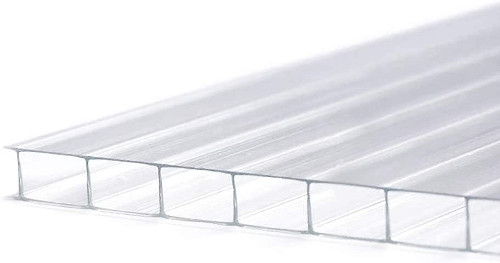
It can be found with as many as three layers and is easy to use.
Coop windows for very warm environments:
For very hot places it is probably best to use hardware cloth or mesh and have a shutter you can close to cover the opening if you need to.
Below: A mesh panels for very hot environments.
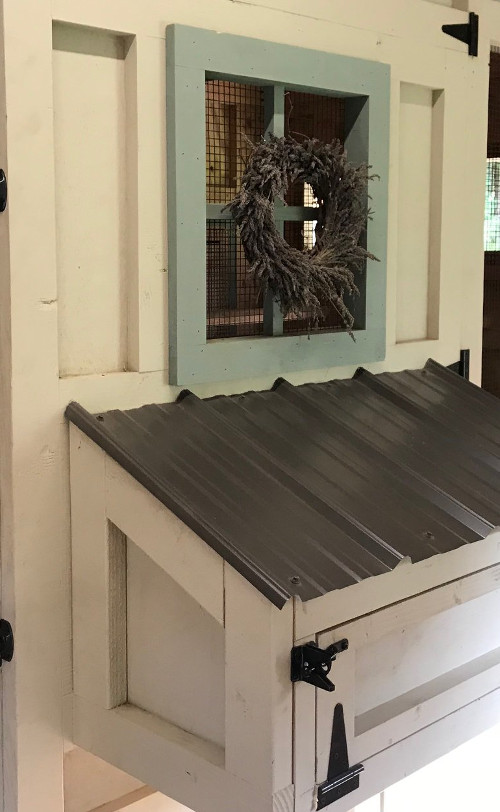
The other ingenious solution I have seen was also borrowed from the horticultural industry. You can buy gas powered window openers that work at a specific temperature so when the air temp goes over 24 C or F the gas struts will automatically begin to open the windows.
Below: An automatic greenhouse vent opener can be put to good use in hot chicken coops.
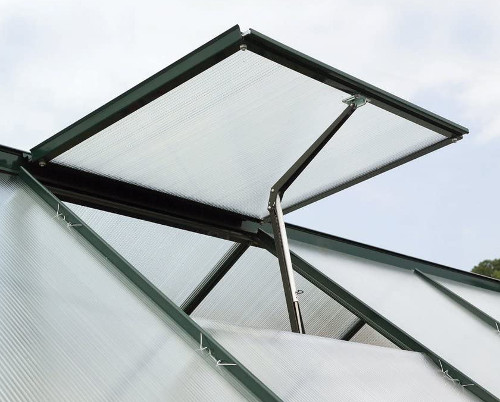
Windows and ventilation in chicken coops:
To purpose of ventilation in a chicken coop is to obtain an influx of fresh air without drafts and without too great cooling of the air already in the coop. Do this and you have solved the problem of ventilation.
To prevent an undue fall of temperature, there must be, in addition to a fresh-air supply, a continuous heat supply, and this exists in the chickens themselves.
The position of the ventilating arrangement depends upon the position of the fowls at night. It is a strange fact that human beings, animals, and poultry can better stand a current of air coming directly toward the front of the head than from the rear or sides; hence I would place the roosts so that the fowls face the window and get the fresh air on a level with the nostrils rather than from above or below.
Thus they are fortified against a drop in temperature. For example, where the roosts are to be two feet above the floor, I would have the windows about twenty inches from the floor, provided the roof is correspondingly low. With the roosts three or four feet above the floor, the window should be from thirty-two to forty-four inches above the floor, etc. I think it is safe to have the windows not higher than eight or twelve inches below the eaves, and six inches from the sides of the building.
Despite the fact that some poultry men have discarded glass, I cannot rule it out altogether. It certainly has its uses on cold wintry days when the heat of the sun's rays is wanted without the chill wintry air.
I believe these glass windows should be covered at night, and that the fabric curtain is therefore the most sensible mode of night ventilation. Burlap, sacking, or coarse muslin may be used to cover the window frames. Burlap is the most substantial. In tacking it to the frame, tacks with tin discs beneath the head (like those with roofing nails) may be used, or a thin light strip of wood may bind the burlap to the frame, and through it the tacks are driven.
Wherever glass is used, some protection of poultry wire is necessary to prevent its being broken.
